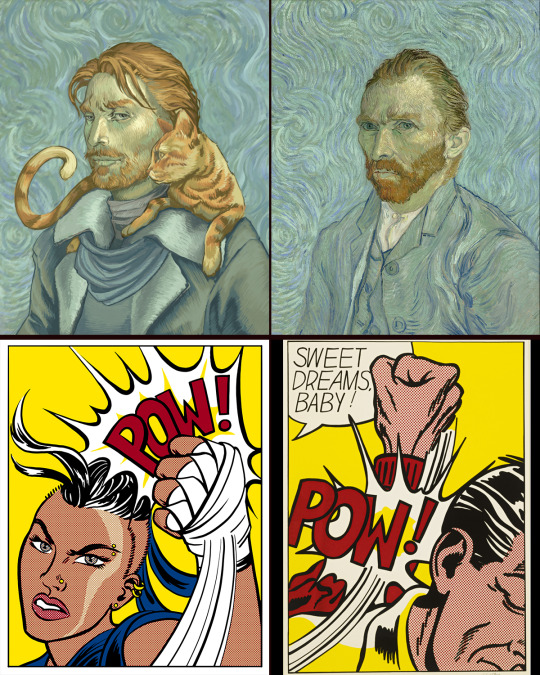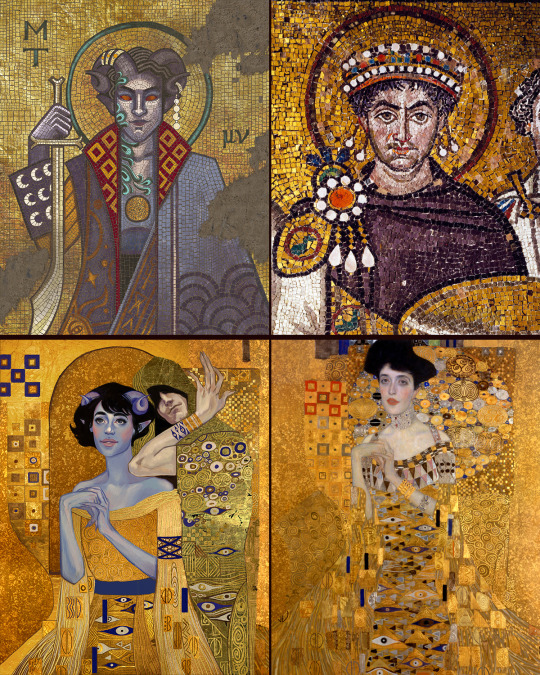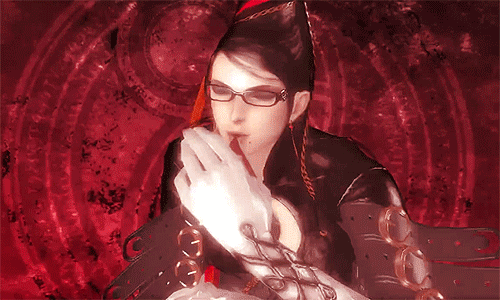Text
recurring themes in our lives - Pluto and Chiron placements

Persephone and Hades
when I think of recurring issues in our lives, I think of placements of Chiron and Pluto by the very nature and effects they both have on us.
Chiron is the wound that takes time to heal and which, more than that, is the wound that hurts but that the native can't even understand and be aware of. Chiron relates to feelings that bad cycles will repeat.
Pluto represents our greatest fears, where we may want to control things (exactly because of the fears) and also where we project ourselves. Pluto hints at the area in which we need to undergo a profound transformation in order to be more evolved and even to stop certain suffering in our lives.
therefore, I decided to bring a post about the recurring themes that Chiron and Pluto touch for those who want to go through this process of consciousness.
Chiron in the 1st house: wound related to own identity, not being able to perceive who you are. feeling incapable of initiating things and being the protagonist of the search for their identity.
Pluto in the 1st house: fear of imposing yourself or fear of being dominated, which can manifest in a few different ways, but the center of it is the intensity and at the same time the lack of control involving your self-image.
Chiron in the 2nd house: wound related to the feeling of comfort, security, the right to relax, to enjoy the pleasures of life. not feel stable and able to acquire security in life situations. living with the feeling of inner insecurity.
Pluto in 2nd house: fear of existing without your material possessions, fear of not having security, interruptions in life regarding comfort and stability, fear of things involving the 2nd house, which can lead to destructive behavior.
Chiron in the 3rd house: wound in relation to communication, free expression, the mind can be quite guided by the idea of incapacity, the feeling that others don't really listen to you, not feel ready for socializations.
Pluto in the 3rd house: fear of everything that involves expressions of what is on your mind. need to guard your thoughts because deep down you may feel that you are not so capable of expressing yourself, that you are not so intelligent.
Chiron in the 4th house: wound about family, feeling that the world or the place you are currently in is not a home for you. the lack of an emotional home, which hurts inside.
Pluto in the 4th house: fear of having your weaknesses and emotional issues exposed, fear of not having a comfortable family and home, which can lead to controlling behaviors.
Chiron in the 5th house: wound related to self-expression and ego. feeling that you are not good, you are not capable and that you will not be seen by others. wound related to the value that people (don't) give you.
Pluto in the 5th house: fear of not being appreciated; fear of no one knowing you. fear of not being loved, not receiving doses of love here and there. fear about the value of the things you do. fear of not being accepted by people.
Chiron in the 6th house: wound in regards to your sense of usefulness to others. wound that can even manifest on physical levels. feeling that you are here to give too much but receive too little. mental time and routine are problems that bring you soul-related wounds.
Pluto in the 6th house: fear of not being useful. fear of not having control of things on earthly levels, feeling that when one thing is out of your control, everything is out of your control. fear of being criticized.
Chiron in the 7th house: wounded with love and the idea of love, either by concrete experiences or by things that the native thinks. that is, there are ideas and fears that were never confirmed - but that native fears that they will one day. wound related to partnerships in general, the idea that people aren't deep enough for a relationship, the "failures" in relationships that cut deep into that individual's soul. wounded in relation to what every individual wants most: to be loved.
Pluto in the 7th house: fear of being alone. fear of not being good enough for others. fear of betrayal. feeling that you are not a good boyfriend or a good girlfriend, a good husband or a good wife. feeling that there will always be someone better. fear of partnerships, but a deep desire to relate.
Chiron in the 8th house: wound in relation to trust. hurt related to manipulation. native sees someone being manipulated a lot. wounded in relation to opening up, the idea of surrender on all levels haunts the individual, paralyzes him/her and makes him/her do several observations before allowing someone into his/her life. despite the difficulty in opening up - even on sexual levels, the apex of human intimacy -, the native can have difficulty discerning what is and what is not manipulation, and at the same time can not know how to close doors at the right times, closing him/herself wrong way.
Pluto in the 8th house: fear of being controlled. fear of being exposed to others. fear of having your privacy in front of others. feeling that all things are deeper than you see, fear of trusting others. fear of surrendering and opening the doors of your vulnerability.
Chiron in the 9th house: wounded about not being intelligent enough and capable of understanding profound things. feeling that things will never work out. a negative preconception of life. beliefs and philosophies of life can be seen in a fatalistic and/or pre-deterministic way. feeling of being lost and without a spiritual guide in this life.
Pluto in the 9th house: fear of not belonging to the world on spiritual levels. fear of expressing the deepest knowledge you have, whether for fear of criticism or exposure. fear of delving into dense knowledge all at once. denial of this, which can lead to the exact opposite of what the native wants to avoid, she/he can become obsessed with some point of a belief or the like because of his fear of not belonging spiritually.
Chiron in the 10th house: wound in relation to reputation, prestige and social recognition. the individual may feel that he/she was "born to be a failure" and that he/she can't get out of a situation to go to a better one. the negative view the natives hav of themselves may be intrinsically linked to how they think society views them or what they believe society expects of them. moreover, at the deepest level there may be a feeling that the goals pursued by people on a social level - career, material goods - are not capable of bringing satisfaction to the native. the native may also have difficulty finding him/herself on social levels - such as in the sense of career and vocation for life.
Pluto in the 10th house: fear of others seeing your inner weaknesses. fear of being publicly exposed. fear of not reaching your goals. fear of being a person out of control of things (or out of control of people). fear of not reaching a pleasant and stable social level. fear of lack of stability.
Chiron in the 11th house: wound in relation to social groups. not feel good enough to join groups. wounded in relation to groups that deny or do not perceive its presence. problems with friendships. feeling that you can't trust others. friendships that are important to you but that hurt too much.
Pluto in the 11th house: fear of not being in any group. problems involving identifications and ideologies. fear of getting involved in group activities. fear of being controlled by others. intense desire to do everything alone, denying their social needs, and at the same time fearing being alone. disharmony in relation to group integration.
Chiron in the 12th house: wound related to being quite deep but not being able to express it. wounded over deeper emotional and psychological issues that can't be expressed for some reason - fears, insecurities and desires are denied by you or by others around you. feeling that there is always something wrong around you, but not being able to deal with it. inner spirituality and life that bring some kind of discomfort to you.
Pluto in the 12th house: fear of knowing your depth. fear of your emotions and insecurities controlling you. fear of getting lost in the world and having nothing to lean on. feeling that your emotional life is so intense that few will understand, so you need to hide your inner life from everyone. fear of letting people get to know you for real. fear of what is deep and unconscious and at the same time a great attraction to it.
6K notes
·
View notes
Text
Heheh i edited it
Aram penta
0 notes
Text
Watch GoldenClaw000 with me on Twitch! He's a goof and a cutie, and he has anger issues :D https://www.twitch.tv/goldenclaw000?sr=a
5 notes
·
View notes
Photo





Well, I finally finished the whole M9 in Art/Pastiche series. I thought you might be interested in seeing the side to side with some of my inspirations. A quick rundown-
Caleb- Van Gogh Beau- Roy Lichtenstein Molly- Byzantine Mosaics Jester- Klimt Matt- Hans Holbein Yasha- 15th Century Illuminated Manuscripts/Gerard Horenbout Fjord- Adventure Pulp Covers Nott- Playing Card Design Caduceus- Mucha
In case anyone was curious- Caleb was the easiest, Jester was the hardest, I’m most pleased with Matt, I’m least pleased with Nott, and Molly took the longest.
Thanks for all your interest! Please feel free to shoot me any questions or comments or suggestions or cheesy jokes anytime you feel like it.
26K notes
·
View notes
Text
https://trovo.live/s/GoldenClaw/213233398
Live rn serbian/english apex streammm
Send some love to the goof 💕
;)

16 notes
·
View notes
Text
90K notes
·
View notes
Text
https://vm.tiktok.com/ZMYNpPpJQ/
When luck or skill has your back?
https://trovo.live/s/GoldenClaw/213233398
:)
0 notes
Text
https://vm.tiktok.com/ZMYLyFNKe/
Apex kill mali ples
https://trovo.live/s/GoldenClaw/213233398

0 notes
Text
my top 10 anime list
tie between Akame ga kill & Elfen Lied. Elfen lied was the first one i saw and i will always have a special place in my heart for it because of that. Akame i’ve watched several times and have read both the manga and the prequel story, Akame ga kill Zero.
Re:Zero. the second season is better than the first and i loved the first season more than anything else i’ve watched in awhile
Higurashi No Naku Koro Ni (When they cry). a total mind-fuck that i love and have watched with a notepad handy to try and keep track of all of the arc’s. i have a couple of the mangas but the story is so immersive and complex that it’ll take a long time to read through them all to get the full synopsis
Mirai Nikki (Future diary). my first survival game anime that i loved from the first episode and have rewatched often
Noragami. why this one doesn’t have a 3rd season is beyond me because the story behind it is one of a kind
Working!! a slice of life that is just wholesome to watch no matter how many times you’ve seen it
Angels of death. not gonna lie, i bought it on a whim and 2 episodes in paused it just to ask WTF AM I WATCHING but it’s great and i adore it to pieces no matter how odd it is
another tie - Angel Beats & Erased. both had me from the pilot and didn’t let go until the ending and the stories behind them are both great and nearly moved me to tears
Another. i watch it yearly around Halloween because it’s a really good horror one that has a mysterious vibe to it.
Darwin’s game. an intriguing premise that is only 12 episodes but still an anime i enjoyed from start to finish.
honorable mentions: Wotokai, Cowboy Bebop, Soul Eater, Konosuba, Rising of the Shield Hero, Fruits Basket, Ouran host club, Fullmetal Alchemist, Inuyasha, Death Note, Steinsgate, My Hero Academia, Food Wars, Ajin: Demi-human, SAO, Parasyte, Hitori Bocci, High Rise Invasion, How to care for a mummy
11 notes
·
View notes
Text
Ok here's a list of instagram artist you should follow:
@byavasan
@shjimaa
@dreamer._.247 (tumblr acc: dreamer-247re.tumblr.com)
@_daminyonok
@virtual_mockingbird
@cranberri.art
@maru_davalos_art
@zalazzart
@voidmash
@t.comics
@taro_wong
@symeona.kanellou
@batboycentral
3 notes
·
View notes
Text
I was thinking Yato is actually a god born from ayakashi, since his father has that emotional indignation of loosing someone as we saw in hints, therefore vengance towards gods and heaven, there must have been ayakashi around him, so gods of Calamity are kind of born by the influence of ayakashi right ? Maybe this was obvious but to me it wasn't and I find it fascinating :D
5 notes
·
View notes
Text
Fe is a mirror
Now, what does that mean? When you meet people with Fe, especially high Fe as in FJs, they will mirror your behaviour. They will adapt to you, to your expectations, to your body language, to your sense of humour. Their own self is constantly changing and adapting, and all the while they are never lying about who they are. That might seem contradictory, but it isn’t. You can think of an FJ’s personality as a mirror that is broken into many different pieces, and depending on who you are, they will show you a different piece you can stare into and see yourself in. Every piece of the FJ is still them, just each a slightly different version.
What this also implies though is that an FJ needs witnesses to their existence in order to be able to see themselves. They need someone to look into their mirror piece and leave a reflection of themselves for the FJ in there. Without someone looking into their mirrors, they are blind. An empty mirror facing an empty mirror will reflect nothing but emptiness. They will stand in front of the mirror for half an hour just staring into their own eyes, having no idea what they are seeing in there. They cannot see themselves on their own. Being locked up all alone in their apartment for weeks or drowning in a crowd of people walking past them without a glimpse - there is no difference. They go unseen. Instead, they need someone, literally anyone to look them in the eyes, so they can see themselves in them. Without being observed, the FJ will feel like every trace of their existence is erased until their entire being has completely gone and all that’s left is an empty shell without a soul.
103 notes
·
View notes
Note
hi! could you tell me about how you would distinct an intp from an istp? literature about ti tends to focus really heavily on how it works with ne. anyways, the more of a rant the better, i follow you from pdb and absolutely love your perspective!
sorry this took so long to answer, i’ve been trying to perfect it. for the future if you want to send me any typology asks do it at @functionaxes
first off i think it would be helpful in clarify how we can think about Ti by itself first and then getting into detail about the perceiving functions and differentiating the types.
Ne/Si and Se/Ni are the two axes of perceiving. and Fe/Ti and Te/Fi are the two axes of judging.
the aim of perceiving functions are to synthesize data without discriminating between that data. it doesn’t designate distinct barriers between things, it just experiences. judging, however, is the conceptual splitting of things from another with the aim of organizing information into definitive concepts (and for the F functions, additional criteria for judging that pays mind to sentiment).
from Function Axes in Jungian Typology:
By perception, we mean any psychic process in which the intentionality and end product is experience. Jung refers to experience as “irrational,” by which he means that raw experience, if taken by itself, is incoherent and dynamic.
By judgement, we mean any psychic process in which the intentionality and end product is a proposition. Jung refers to judgments as “rational,” by which he means that formal propositions, if taken by themselves, can be coherent and stand apart from reality even as the experiential elements the propositions pertain to have changed.
Ti, like Fi, is an introverted judging function (Ji) which means it tries to be self-aligned by differentiating the qualities of a single subject and evaluating something for its inherent/static qualities. it evaluates how a thing compares to itself rather than how it compares to other things in a causal way like Fe and Te do (Je). basically what something “is” is not classified by its applicable function or its causality, but instead its essence; what something “is” to Ji is everything that‘s left once other things that are not “it” have been omitted. Ji can judge the qualities of objects, concepts, or even one’s self as something to keep in alignment with.
as for what Ti is exactly, it’s helpful to contrast it to Fi.
Fi defines singulars in a way that is contingent on matter (as evidenced by how finely-diced and unique Fi users’ values are about things since no two things are exactly alike when it comes to matter), i assume that would make it more specific and nuanced about the essence of things and thus more particular about their values. matter is also what Te bases its criteria for judgement upon: as Aristotle put it, “it would be absurd to try to prove ... what is obvious by what is not” so it makes sense that this extends to Fi as well. Ti just kinda sees matter as useless when it comes to defining things by essence. Ti is super ontological and defines stuff using categorization that floats “above” matter, therefore individual differences by virtue of matter are kinda negligible (and that's where Fe comes from: making external decisions on the assumption that we’re all similar but like in a meta way). you can think of Ti classification as sort of like... taxonomy? at least that's how i experience it. which is why Ti is more general and broad about its definitions since it does so from different levels of magnification depending on scope, with more specific (small) categories and more general (larger) categories. “we are all homo sapiens” is an inherent justification for how we are more similar than we let on, whereas Fi would be more inclined to think “yes but every homo sapien is unique” since the judgement is contingent on matter. also note that i mean “unique” here in a neutral way—Fi users see each thing as having qualities that are inherent and unique to each of those things, regardless of what the Fi user’s personal sentiment towards each of them is. which means we can say that Fi is more inclined to look at differences and Ti is more inclined to look at similarities. Ti really only tends to look at differences when it comes to justifying why groups are split a certain way, but not everything is seen as unique to Ti like with Fi. pretty much everything is seen as similar in some ontological, semantic, or categorical way that transcends matter alone.
to see what Ti looks like in comparison to Je functions let’s take the singular “chair” for example. Ti conceptualizes stuff according to ideal ontological properties. so “what constitutes as a chair at the bare minimum” is a Ti sort of question. to me, the static self-aligned components that make a chair are: “if it makes sitting upright at some level above the floor possible, it is a chair.” my ISTP friend says “glasses are chairs if you think about it.” i mean it wouldn’t be comfortable and could hardly be considered much of a change from sitting on the floor (which is my auxiliary Fe function talking), but technically they’re right if we are aligning with what that essential definition of a chair is (which is my tertiary Ti function talking). and the contents of everyone’s Ji is going to be different, how things are self-aligned is going to differ from person to person, unlike with Je where we could all agree “glasses as a chair” goes against common sense because it’s impractical (hence what i mean by Je’s judgements being causally-derived), even if it “technically” fits Ji’s subjective proposition.
basically, perception is this:

judgement discriminates between them based on categories and properties that don’t require you to actually experience perceiving them and can stand apart from reality. you can read the following without having to have ever seen these shapes:
A square is a closed figure with four straight sides of equal lengths and four right angles. A rectangle is a closed figure with four straight sides and four right angles. Therefore, a square is a type of rectangle, but not every rectangle is a square.
Cool. tell me about ISTPs
so basically ISTPs are going to explore these judgements with Se.
Se is a little weird because it “grounds” Ti a bit based on what is directly observed in reality. ISTPs experience reality viscerally, but their comprehension of it will be semantic in nature rather than nomological (the way Te would).
see, Te creates judgements based on how something can yield practical results. Te could care less about why something works, it just focuses on it working (and if seeking to know why/how something works, usually does it ultimately for practical results, such as in learning coding for example. the goal is to make a functional application, not to learn a coding language and aimlessly play with it like a sandbox just for the sake of it. i’m not saying Te users can’t do this but they very likely have some developed Fi for the intrinsic motivation of it if they’re gonna be doing that.)
Ti seeks to fully know the reason why something works, exceptions to rules, and seeks alignment with their “truth” no matter how impractical it may be. so like INTPs, ISTPs aren’t really doing stuff with reaping extrinsic rewards or results in mind, but more so for the sake of intrinsic motivation, self-alignment, and exploration like other IxxPs.
Ne/Si (INTP) vs. Se/Ni (ISTP)
because Ti’s judgements “hover above” reality, it’s often more conflated with Ne than Se because Ne’s short-term associations also hover above reality.
check out this at-a-glance comparison of Se/Ni vs. Ne/Si here, and you can read my essay i wrote for school in which i elaborate on the technical difference between Se/Ni and Ne/Si (with the primary focus being on defining Se/Ni), but basically:
after a stimulus is detected,
Ne quickly moves on from direct observation, as the user's observations are turned into mental facsimiles and associations that are indirect, recalling past details in seeing how they might relate to the present or considering new perspectives adjacent to what is concretely in front of them.
Se locks in and directly enhances the present properties, deriving inspiration from, and about, the immediate objects and factors themselves. Se is just a double layer of acute observation that is more “extreme” than the average person, where the focus lingers directly on, and about, a present, concrete factor.
this makes ISTPs generally more pragmatic than INTPs, (though not necessarily practical), more visceral, gritty, and hands-on.
i think one of the best ways to tell the difference is that INTP is pretty much always gonna be more of a “cloudcuckoolander” due to Ne/Si.
ISTPs are cautious with extrapolations; they don’t make disparate superficial connections willy-nilly due to Ni, as insights have to come from some basis in raw observed reality to begin with over time, but they are proactive with exploring concrete objects in their entirety.
INTPs are cautious about concrete experiences; they are generally more inclined not to take new experiences at face value due to Si, but are proactive with exploring new connections and fiddling with ideas. they will generally explore something from at a bunch of different angles, all but directly.
ISTPs, like INTPs, can also very philosophical due to Ti. what comes to mind is Bruce Lee’s “be like water” speech, or the entire existence of Skips on the regular show. with more developed Fe you can really see how they fit with the rest of type family B (ENFJ, INFJ, ESTP) but a bit different, more withdrawn in their judgements than the others but more grounded in the experiences of the present.
ISTPs aren’t always all business, nor are they all sporty. bob belcher is a good example of what a typical ISTP looks like irl. they can be just as eccentric as INTPs (x), but because Se is more “objective” than Ne (by which i mean that everyone else can see something exactly as the Se user is seeing it; Ne is more subjective since not everyone is going to see the short-term connections as they do) it mutes that eccentricity in that they’re not all over the place. but their quirks are very much there (x) and it’s very charming when you see it.
i really don’t like that ISTPs are perceived as “less friendly” INTPs. they may seem to come off as more blunt or cold but that is because they are not inclined to humor short-term possibilities like INTPs by virtue of already perceiving that such a possibility wouldn’t work out. this is because an underlying narrative was synthesized and excavated from prior direct experiences and they can apply it to all similar narratives that would play out in a similar way, regardless of specific details. but their judging function placements and roles are exactly the same.
Ti + Ni
i am an INFJ and i have experience with Ni + Ti, i just use them in a different from way from ISTP. (my Ti judgement is contingent on my Ni perception, my Ti is very much tertiary and I ultimately use it make sense of and rationalize my perceptions rather than leading with it.)
so when having both it’s kinda hard to determine which is which when i’m using them, but as i said, Ni is a perceiving function and it doesn’t differentiate one thing from another. Ni excavates the existence of universal narratives that run beneath a body of unrelated experiences, and disregards the specific details of those experiences in favor of emphasizing the similar narratives between them. what comes out of me verbally or in text is a best approximate articulation of that vision which has been filtered through Fe and Ti to make sense of it, unfortunately bound to the confines of language. that’s why i use examples and metaphors a lot and why my posts get so long lol because i want you to be able to have the same insight as i do, i want you to be on the same page as me experientially seeing the same narratives in the way i do. Fe/Ti and Se (when i show you examples) is my means of doing that. my analogies are very general because having Se in the stack emphasizes the need for shared, universal experiences. for example, water... everyone has seen water. everyone knows the properties of water, how it moves and how it interacts with things. people’s experience with water is universal, which is the perfect subject for an analogy. that’s where ISTP bruce lee got his “be like water” speech from.
the presence of Ti/Fe only adds to that, which makes the Se/Ni + Ti/Fe combo (type group B) the most holistic, universal, and objective in that they see their experiences and values as being applicable to everyone and everything else as well. that’s why the types in this group tend to have that sort of a "guru" vibe regardless of whether they actually are spiritual or not. the similar thing about every type in this group is that they tend to be inclned to pass on knowledge or wisdom in some form because they are confident about universal application and value. of course people of every type like to help people, not just this group. but the types in the Se/Ni + Fe/Ti family (ESTP, INFJ, ENFJ, ISTP) just have a similar “guiding” thing they do, i can’t really explain but i hope you see what i mean.
but Ni and Ti are actually really similar, just in different ways. they are simultaneously vague and general while the subject they're both differentiating and perceiving feels pinpointed and clear. Ti and Ni are both really general in terms of their content, but specific about that generality.
but articulating that is like Shit Fuck which probably explains why ISTPs often don't bother to tell anyone much (not a necessary aspect of them though) and are generally seen as more “quiet” and “mysterious” than their Ne/Si counterparts. i cant blame them, it’s often really hard to put into words. Ti is meta as fuck with its ontological categories so its hard to communicate it to others, and Ni is meta in its perception of reality (where a present situation/object is perceived as being merely an example of or representative of a greater narrative). inferior Fe further disincentives wanting to explain it to anyone and tertiary Ni sees it as being pointless before you even consider it.
TL;DR
attributing INTP aspects to descriptions of dominant Ti (and thus also to ISTPs) has been addressed here where it pretty much covers what you asked for, but i wanted to go all out so you gain a more well-rounded perspective.
TL;DR (again)
(btw not all INTPs are as talkative and fruity as rusty just letting you know. but the group A types (Ne/Si + Fe/Ti) tend to have this scattered cloudcuckoolander wine mom energy INTPs included. here’s some other examples of an INTP and ISTP together too to compare.)
99 notes
·
View notes








